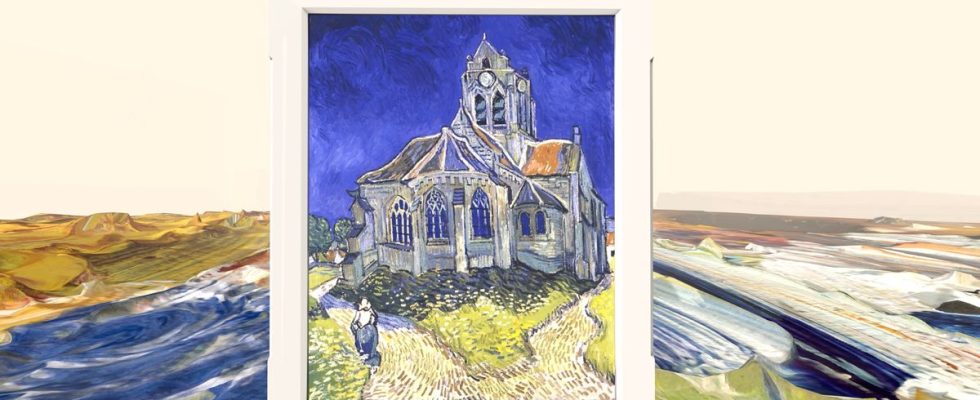Immerse yourself in Van Gogh’s palette. On the sidelines of the exhibition Van Gogh in Auvers-sur-Oise – The last months which opens its doors to the public this Tuesday*, the Musée d’Orsay invites visitors to immerse themselves in the painter’s creative universe with a VR headset on their heads. 20 minutes was able to test this experience in preview.
“A technological leap”
Before discovering around forty works (among the seventy-four existing) that the tireless painter created during the two months spent in Auvers (95), before killing himself on July 27, 1890, a room is dedicated to entry into a new experience called Van Gogh’s palette, which the general administrator of Orsay, Pierre-Emmanuel Lecerf describes as “a technological leap, but also a moving moment”. And it is HTC, the manufacturer of virtual reality headsets, through its HTC Vive Arts division, which is in charge.
In this space, twelve helmets XR Elite await visitors. This high-end model (worth 1,399 euros) and lightweight despite its integrated battery (275 g) has four cameras. Here, they make it possible to materialize the hands of the user, called upon to interact with content. The headset also includes its own earphones. Once seated on a rotating stool, it’s time to dazzle! Not recommended for children under 8 years old, the experience is accessible to people with reduced mobility.
Mix colors
We are immediately projected into the house of Doctor Gachet, the art-loving practitioner, immortalized by Van Gogh and one of his paintings. Margueritte Gachet, the doctor’s daughter, plays the narrator: “Mr. Vincent used up an incredible number of tubes, red, green, Prussian blue. He complained a lot, he often said that he never had enough.” Our hostess invites us to grab a paint palette, placed on the living room table. All you have to do is extend your arm to make it yours.
VR obliges, the idea is not to remain static on your stool, but to turn on the seat, raise and lower your head, let your gaze be caught by this or that detail. And even to play with the material. Which we don’t take long to do. As bubbles of color float in the air, we can manipulate them, mix them, distort them and, perhaps, understand how Van Gogh combined his tubes of colors. These few minutes are full of poetry.

Emotional too, as with this evocation of the painting called “Tree Roots”. Painted on the same day of Van Gogh’s suicide, the work is revealed in a new light in virtual reality. Thus the visitor is sucked into the intertwining of the blue and bare roots of the painting, caught beneath the surface of the ground, subject to an almost suffocating sensation when, upon raising his head, a majestic tree is revealed above him. Disturbing… We cannot help but be struck by the feelings which must have oppressed the painter, who shot himself in the head a few hours after having completed his painting. “My life too is attacked at the very root,” he wrote a few days earlier…
A route framed in time and technically structured
Throughout the VR journey, a kingfisher serves as a common thread. Simply follow it to move from one interactive world to another. A route which, although merging, remains logically limited in time: ten minutes. We would have liked to be able to linger here or there, sometimes to enjoy this or that sequence more. HTC’s XR Elite headset, supposed to offer a “play” zone of up to 10 meters, is used here statically, seated. The experience offered by the Musée d’Orsay, whose logistical constraints we understand, is therefore deliberately limited technically. A development in augmented reality, merging images of today’s Auvers-sur-Oise with those immortalized by Van Gogh, would undoubtedly have merited work. But the 6 euros requested for this VR stroll in addition to the exhibition visit price* definitely worth it.
If HTC provided the technical part of this experience, Orsay partnered with Lucid Realitiesa French company specializing in immersive experiences, and the documentary production company Please turn to propose his joyful Van Gogh Palette.
Reach new communities
By carrying out this experience, all the potential that technology can bring to art, and to pictorial art, which, as here, has absolutely nothing fixed in its frames, is also revealed. “This allows us to reach communities and audiences who are not necessarily interested in the museum, to modernize our image through gamification and gamification,” confirms Agnès Abastado, digital director at the Musée d’Orsay. Orsay Museum which will not stop there. For the 150th anniversary of Impressionism, the establishment is preparing, again with HTC Vive Arts, a new experience. Even more ambitious, it should be able to bring together up to 80 people equipped with a virtual reality headset simultaneously in an area of 500 m2 without having to remain static. See you in 2024 for an exhibition which, for the rest, will be very real!
* from October 3, 2023 to February 4, 2024. Free entry for people benefiting from thefree ; 16 euros (full price).

